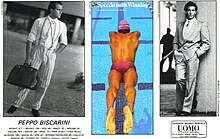Sedcard
Sedcard (further spelling: Sed-Karte ) denotes - especially in the German-speaking area - an application document for models at agencies , magazines or photographers . The internationally used name is Comp Card (from English composite ).
General
As is customary in the industry, the official presentation of a model takes place using a model book and a sedcard.
Today all established model agencies expect their applicants to submit professional photos for their model files. The top agencies in particular do not accept amateur pictures. As a rule, the model must provide the agency with a ready-made sedcard or at least professional pictures. Beginners and semi-professionals usually have to try to create high-quality images for a sedcard or model book themselves, so that they can then be presented to the agency scouts.
details
A model book made of leather or plastic contains 6 to 12 pages in the minimum format DIN A4 . Each side is a sturdy plastic cover and holds a large-format picture on the front and back. The welcome page should contain a sheet of paper with the artist name and personal measurements. Special skills and references can be documented on the sheet at the end of the folder. A total of 10 to 22 photos can be presented.
A sedcard is a cardboard card printed on both sides in DIN A5 , sometimes DIN A4 or US statement / half , with meaningful photos and the most important data about the model.
On the front there is space for the artist name with a large face photo. The back shows 2 to 4 more pictures, a list of personal body measurements, the contact details and, if applicable, an address label of the agency.
Name story
Sedcards are named after the inventor Sebastian Sed , the managing director (with partner Dorothee Parker ) of the British model agency Parker-Sed. In the 1960s, it was one of the first agencies to operate on many continents, with offices in Hamburg and New York City, among others . To simplify the selection and booking of international models, Sebastian Sed developed a standardization that was quickly adopted by other agencies. His little "invention" did not make Sebastian Sed rich; the Parker-Sed agency was closed in 1993. But the SedCard has stayed.
In the United States , Sebastian Sed's surname was always pronounced as "Zed" (English "Z" pronounced as a voiced "S"). This is how the names Zed Card or Sed Card came about. The most common international name is Comp Card . Often, “Sedcard” is also incorrectly written as “Setcard” (with “t”), derived from a film set or photo set. Another misleading explanation refers to sed as the short form of the English verb to seduce = to seduce.
conditions
The sedcard is intended to provide a general overview. The agency scouts therefore want several shots with very different looks in varied outfits in different locations. The black-and-white and color photos are intended to present the model's complete personality and include both facial and full-body photos.
Depending on the desired area of application, the model shows its particularly advantageous sides in different perspectives , for example the face, hairstyle, hands or feet or even the whole body.
literature
- Dietmar Kreutzer : Pure male models . Dreams, Jobs & Agencies. Verlag Bauwesen, Berlin, 1999, ISBN 3-345-00732-0 .
- Daniel Kötz, Eva Gabriel-Jürgens: Fees and rights for models . KÖGA list 2011/2012. In: Edition ProfiFoto . mitp, Heidelberg / Munich / Landsberg / Frechen / Hamburg 2010, ISBN 978-3-8266-9150-8 .
Web links
- Production of a sedcard for photo models - explanation of the layout design and print preparation
